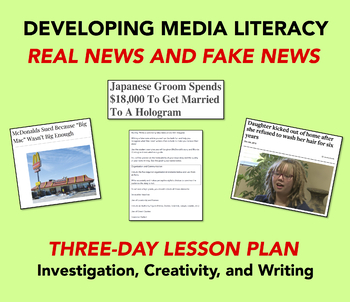Developing Media Literacy: Real News and Fake News
- PDF
- Internet Activities
Description
Published January 2019: With so much fake news being called real and so much real news being called fake, how is a young person (or anyone) supposed to know the real truth in the “post-truth world”? This is a three-day lesson plan with recently written real news and fake news articles provided that gives students an introduction to the topic of media literacy and fake news. It also helps develop their investigation, creativity, and writing skills by providing three interesting activities for them to complete. Please see the Preview for some of the materials used.
PLEASE NOTE:
*Students will need internet access to complete the activities in this unit.
*To avoid partisan debates over politics, religion, or other controversial issues I have intentionally avoided using stories or examples that are contentious or could lead to trouble with parents or the wider community. All stories, background, and examples used are appropriate for students of all backgrounds and beliefs.
What will students do?
Look below to see a suggested outline of the learning process (these instructions are also included in the resource).
Day 1: Introduction to the terms media literacy, real news, and fake news using background material, definitions, and discussion questions. Review of the six strategies for recognizing fake news are presented to the class. Then as a closing students create two fake banner headlines using a website given. (They are shown an example of one believable and one non-believable banner before they begin)
Day 2: Students practice using the strategies they learned in the first lesson to evaluate five different news stories by an online investigation and search. All the stories are non-political, non-controversial, and appropriate for all students. A record sheet is provided for students to record their decision on whether the stories are real or fake and of course, answers are provided for the teacher!
Day 3: Students will try and write their own fake news story by looking at two student-created examples and the five organizational elements found in all believable and factual news. Writing a fake news article can be both fun and help students recognize what fake news’ writers often include to make you believe their story (and how they fail when they do not).


